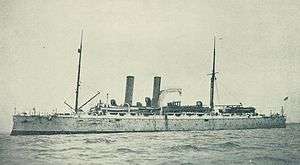HMS Vulcan (1889)
 HMS Vulcan as a torpedo depot ship. | |
| History | |
|---|---|
| Name: | HMS Vulcan |
| Builder: | Portsmouth Dockyard |
| Launched: | 13 June 1889 |
| General characteristics | |
| Displacement: | 6820 tons |
| Length: | 350 ft (110 m) pp |
| Beam: | 58 ft (18 m) |
| Draught: | 23 ft 6 in (7.16 m) |
| Propulsion: | Humphrys and Tennant. 12,000 IHP twin screw |
| Speed: | 20 kts |
| Complement: | 432 |
| Armament: |
|
| Armour: | Steel deck, 2.5-5 in |
HMS Vulcan was a British torpedo boat depot ship launched in 1889, later converted to a submarine tender in 1908-09.[1] As a training hulk, she was renamed HMS Defiance III in 1931 and used for training at Torpoint, Cornwall. She was scrapped in Belgium in 1955.
Construction
The increasing numbers of torpedo boats which had entered service produced the need for a specialist support ship. Vulcan could carry six torpedo boats on her deck and had repair workshops and equipment stores. She had an armoured deck and could act as a light cruiser.[2]
Service history
Vulcan was launched on 13 June 1889. Captain Henry Jackson was appointed in command in December 1899, when she served as a torpedo depot ship on the Mediterranean Station. Captain Charles John Briggs was appointed in command on 12 December 1901.[3]
Robert Falcon Scott served aboard Vulcan as a midshipman.
By 1919, Vulcan was serving as a depot ship. On 18 October 1919, she was in harbour at Blyth, Northumberland (NZ319816) for repairs to her main engines and moored a few yards from the Royal Navy submarine HMS H41 when, during the afternoon, she built up a head of steam and began to carry out a slow-speed trial. In the restricted waters of the dock basin the suction from Vulcan′s propellers drew H41 towards her and, despite the efforts of both crews to keep the two vessels apart, Vulcan′s screws struck the stern of the submarine, cut through her outer casing, and sliced open her pressure hull. H41 sank quickly, but her crew escaped.[4] H41 later was raised and sold for scrap.
Notes
- ↑ Jane's Fighting Ships 1919, pp. 139-140. London: Sampson Low, Marston & Company, 1919
- ↑ Clowes p.41
- ↑ "Naval & Military intelligence". The Times (36638). London. 14 December 1901. p. 12.
- ↑ Gray, Edwyn (1996). Few Survived A Comprehensive Survey of Submarine Accidents and Disasters. London: Leo Cooper. p. 107. ISBN 9780850524994.
References
- William Laird Clowes (1903). 'The Royal Navy: a history from the earliest times to the present, Vol 7'. London: S.Low, Marston and company. (available at internet archive)